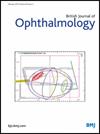Temporary silicone oil tamponade for persistent macular holes: a multicentre study
IF 3.5
2区 医学
Q1 OPHTHALMOLOGY
引用次数: 0
Abstract
Background Persistent full-thickness macular holes (FTMHs) following primary surgery represent a therapeutic challenge. Various surgical treatment approaches have been proposed. This study evaluates anatomical and functional outcomes of a temporary silicone oil tamponade in persistent FTMH in a larger cohort. Methods In a retrospective multicentre study, we included consecutive patients with persistent FTMH following vitrectomy with inner limiting membrane peeling and gas tamponade who were treated by a temporary silicone oil tamponade. FTMH morphology in optical coherence tomography, minimum linear diameter (MLD), closure rate and best-corrected visual acuity (BCVA) change were assessed. Results A total of 102 eyes of 102 consecutive patients were included. Median duration of silicone oil tamponade was 16.6 weeks (interquartile range (IQR) 12.0–22.1). Closure of the macular hole (flat/closed configuration) was achieved in 92.2% of eyes. Median BCVA improved significantly from 1.00 logMAR (IQR 0.70–1.15) to 0.70 logMAR (IQR 0.49–1.00; p<0.0001). Mean preoperative MLD was 460.7 µm (±194.2; range 136–1016), with significantly higher MLD in eyes with unsuccessful (614.4 µm±250.4) compared with successful (446.9 µm±183.9; p=0.019) silicone oil treatment. Conclusion Treatment of persistent FTMH with a temporary conventional silicone oil tamponade without retinal manipulation or postoperative positioning results in a high anatomical success rate and significant mean BCVA improvement. Success rate decreases with higher FTMH size. Data are available upon reasonable request.暂时性硅油填塞治疗持续性黄斑孔:一项多中心研究
背景:原发性手术后持续的全层黄斑孔(FTMHs)是一个治疗挑战。已经提出了各种手术治疗方法。本研究在更大的队列中评估了暂时性硅油填塞治疗持续性FTMH的解剖和功能结果。方法在一项回顾性多中心研究中,我们纳入了玻璃体切除术后伴有内限制膜剥离和气体填塞的持续性FTMH患者,这些患者采用临时硅油填塞治疗。评估FTMH光学相干断层成像形态学、最小线径(MLD)、闭合率和最佳矫正视力(BCVA)变化。结果共纳入102例患者102只眼。硅油填塞的中位持续时间为16.6周(四分位数间距(IQR) 12.0-22.1)。92.2%的眼睛实现了黄斑孔闭合(平/闭)。中位BCVA从1.00 logMAR (IQR 0.70 - 1.15)显著改善至0.70 logMAR (IQR 0.49-1.00; p<0.0001)。术前平均MLD为460.7µm(±194.2;范围136-1016),不成功的眼MLD(614.4µm±250.4)明显高于成功的眼MLD(446.9µm±183.9;p=0.019)。结论临时常规硅油填塞治疗持续性FTMH,无需视网膜操作或术后定位,解剖成功率高,平均BCVA明显改善。成功率随FTMH大小的增大而降低。如有合理要求,可提供资料。
本文章由计算机程序翻译,如有差异,请以英文原文为准。
求助全文
约1分钟内获得全文
求助全文
来源期刊
CiteScore
10.30
自引率
2.40%
发文量
213
审稿时长
3-6 weeks
期刊介绍:
The British Journal of Ophthalmology (BJO) is an international peer-reviewed journal for ophthalmologists and visual science specialists. BJO publishes clinical investigations, clinical observations, and clinically relevant laboratory investigations related to ophthalmology. It also provides major reviews and also publishes manuscripts covering regional issues in a global context.

 求助内容:
求助内容: 应助结果提醒方式:
应助结果提醒方式:


